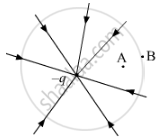Advertisements
Advertisements
प्रश्न
An isolated point charge particle produces an electric field `vecE` at a point 3 m away from it. The distance of the point at which the field is `vecE/4` will be ______.
पर्याय
2 m
3 m
4 m
6 m
उत्तर
An isolated point charge particle produces an electric field `vecE` at a point 3 m away from it. The distance of the point at which the field is `vecE/4` will be 6 m.
Explanation:
The electric field E produced by a point charge at a distance r from it is given by the equation:
E = `(kQ)/r^2`
Where k is Coulomb's constant and Q is the charge on the particle.
Let the distance of the point where the electric field is `E/4` be x metres away from the particle.
So, the electric field at this point can be calculated as:
`E/4 = (kQ)/x^2`
Also, we know that the electric field at a point 3 metres away from the particle is E. So we can write:
`E = (kQ)/3^2`
Equating these two equations, we get:
`(kQ)/x^2 = (kQ)/(3^2 xx 4)`
In simplification, we get:
`x^2 = 3^2 xx 4`
`x^2 = 36`
Taking the square root of both sides, we get:
x = 6
Therefore, the distance of the point where the electric field is `E/4` is 6 metres away from the particles.
APPEARS IN
संबंधित प्रश्न
What is the amount of work done in moving a point charge Q around a circular arc of radius ‘r’ at the centre of which another point charge ‘q’ is located?
The field lines of a negative point charge are as shown in the figure. Does the kinetic energy of a small negative charge increase or decrease in going from B to A?

Why must electrostatic field at the surface of a charged conductor be normal to the surface at every point? Give reason?
The bob of a simple pendulum has a mass of 40 g and a positive charge of 4.0 × 10−6 C. It makes 20 oscillations in 45 s. A vertical electric field pointing upward and of magnitude 2.5 × 104 NC−1 is switched on. How much time will it now take to complete 20 oscillations?
The intensity of the electric field at a point at a perpendicular distance ‘r’ from an infinite line charge, having linear charge density ‘λ’ is given by:
A charged oil drop weighing 1.6 x 10-15 N is found to remain suspended in a uniform electric field of intensity 2 x 103 Nc-1. Find the charge on the drop.
A charge Q is placed at the centre of the line joining two point charges +q and +q as shown in the figure. The ratio of charges Q and q is ______.

Electric lines of force about negative point charge are ______
Two equal point charges of the same sign are fixed on the y-axis, on either side of the origin equidistant from it, with the distance between them d. A third charge moves along the x-axis. The distance of the third charge from either of the two fixed charges when force on the third charge is maximum will be ______ cm.
[d = 10 cm]
Consider two identical point charges located at points (0, 0) and (a, 0).
Is there a point on the line joining them at which the electric potential is zero?
